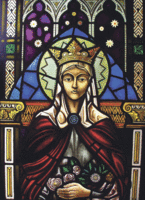Columns
Msgr John Broadbent
November 2012
 St Elizabeth, a daughter of King Andrew II of Hungary and Gertrude of Merania, was born in 1207.
St Elizabeth, a daughter of King Andrew II of Hungary and Gertrude of Merania, was born in 1207.
At the age of four, she was promised to the landgrave of Thuringia’s son, Louis, and was brought up in the castle of Wartburg with her future husband.
What was a planned marriage turned into a rather beautiful love affair.
Love blossoms
As she grew up, she encountered many insults and much unkindness from members of the landgrave’s court, but the young Louis became more and more enamoured of her.
In 1221, Louis being now 21 and landgrave in his father’s place, and Elizabeth 14, their marriage was solemnised, in spite of attempts to persuade her to return to Hungary. He declared he would rather cast away a mountain of gold then give her up.
A contemporary describes her as ‘perfect in body, handsome, of a dark complexion, serious in her ways and modest, of kindly speech, fervent in prayer and most generous to the poor, always full of goodness and divine love’.
The marriage lasted only six years, and they had three children (a boy and two girls). An English writer said of this love match that it was ‘an idyll of enthralling fondness, of mystic ardour, of almost childish happiness, the like of which I do not remember in all I have read of romance or of human experience’.
One of Elizabeth’s ladies-in-waiting used to wake her in the middle of the night to pray and if she was very sleepy she pulled her foot. One night, by mistake, she pulled Louis’s foot, but he forgave her.
Committed to the poor
Elizabeth’s goodness to the poor was so great it often resulted in adverse criticism. This was especially so in a great famine in 1225 when she apparently exhausted the treasury to provide corn for the poor and hungry. Always Louis would back her up to those who criticised.
Wartburg castle was built on top of a steep rock, so Elizabeth built a hospital at the bottom for those too weak to walk up. Here, she fed them with her own hands, made their beds, and attended them even in the heat of summer.
Helpless children, especially orphans, were provided for at her own expense. She fed 900 daily at her gate. The revenue in her hands was truly the patrimony of the distressed.
But she was not to be walked over, either. She did not encourage idleness but got those who were able to engage in work suited to their strength and ability.
When the sixth crusade was called by the Pope, in 1228, Louis volunteered. En route to the Holy Land he died of the plague at Otranto. Elizabeth was half crazed when she received the news a month after the death. She ran through the corridors of the castle shrieking in sorrow.
Elizabeth’s young son was now landgrave. Her brother-in-law, who was regent, drove her and her children from the castle in a bid to seize power. She took shelter in a monastery where her aunt was abbess. What little she had was now shared with the poor.
Taking orders
The Hungarian royal family tried to make another marriage for her, but she had promised to give her life to God in the Third Order of St Francis. She took the unbleached gown and cord in the presence of her relatives on Good Friday, 1227.
Many of her biographers disagree on the wisdom of the one who became her spiritual director. He made her dismiss her two loyal ladies-in-waiting, who were her friends and life-long companions.
What was left of Elizabeth’s life was deeply committed, and she fished in streams and wove clothes for the poor. She fell ill and died on November 17, 1231, aged just 23. She was the first member of Franciscan Third Order to be declared a saint, in 1235.
In the archdiocese, there is a small memorial to St Elizabeth. The church in Normandale on the Western Hutt hills was opened and dedicated to her in 1967 but closed for lack of priests several years ago.
However, the little chapel off the foyer at Ss Peter and Paul in Lower Hutt was dedicated to St Elizabeth and some of the window of the Normandale church incorporated.
Steven Szyranyi, a Hutt parishioner and builder recently deceased, built St Elizabeth’s church for barely living wages. He chose his lovely Hungarian saint, now perpetuated in Ss Peter and Paul’s chapel.
Image: Stained glass from St Elizabeth’s church in Grave, Holland. Link: